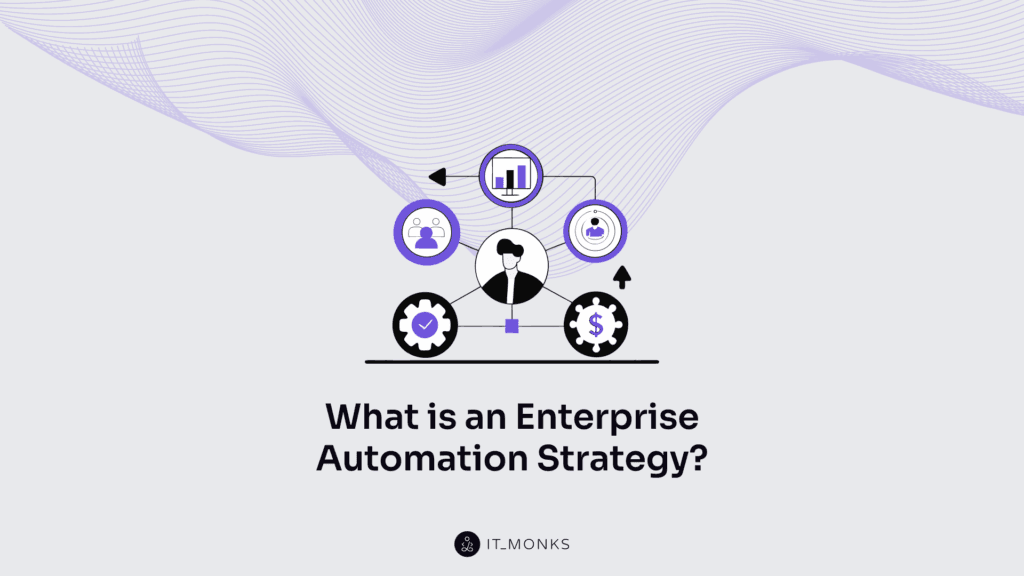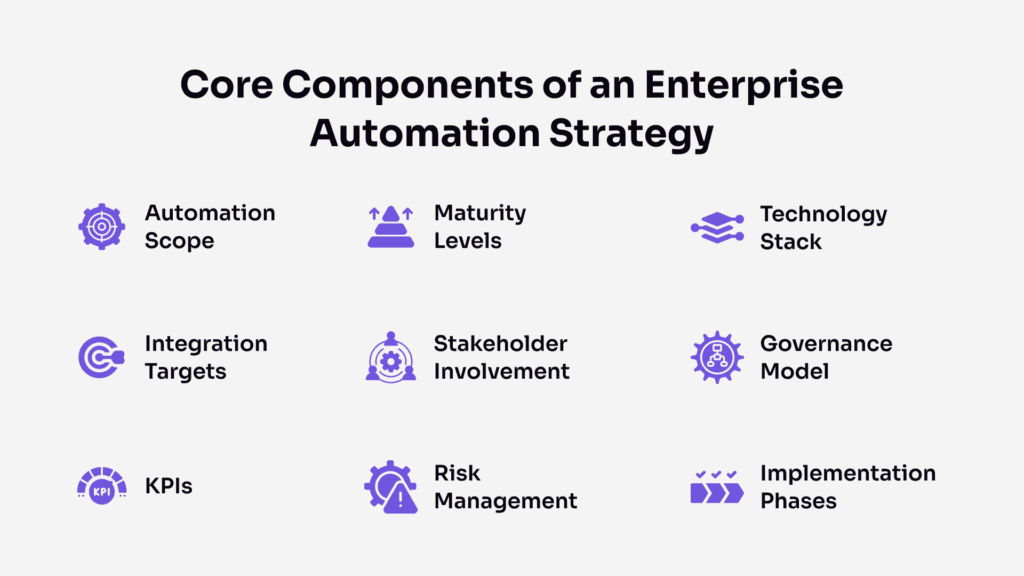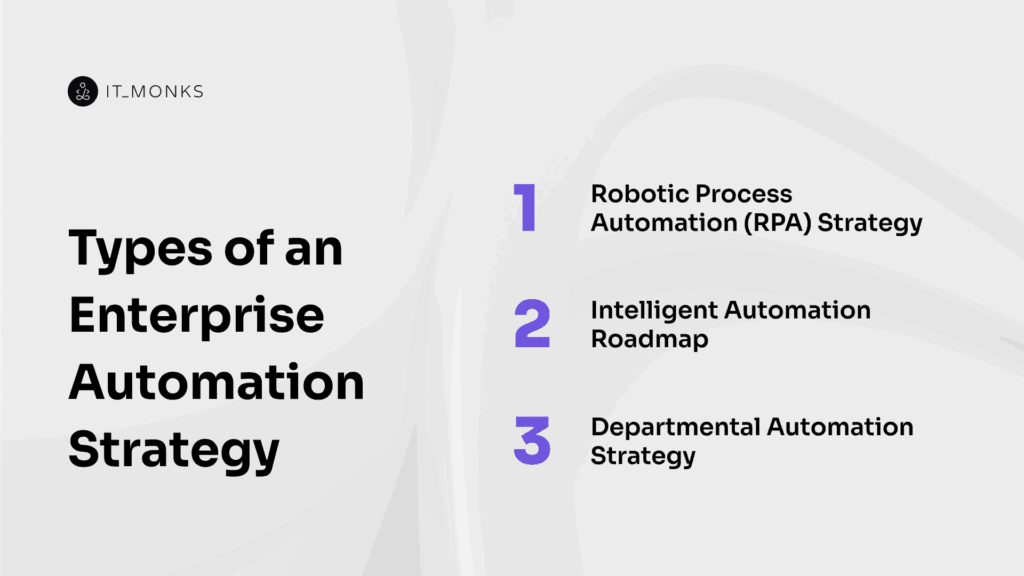What Is an Enterprise Automation Strategy?
Table of Contents

An enterprise automation strategy is the strategic use of technology by organizations to streamline business processes, aiming to reduce manual effort and enhance operational efficiency.
The primary purpose of an enterprise automation strategy is to automate repetitive tasks, minimize errors, and free human resources for higher-value activities.
To achieve such results, an enterprise automation strategy uses its core components, some of which are automation scope, maturity levels, and technology stack. They provide structure, ensure consistency, and address all critical aspects of automation across the organization.
The core components of enterprise automation are implemented by key frameworks that provide standardized methods for implementing automation, offering security, clarity, and consistency. Common types of key frameworks in enterprise automation strategy include ITIL for service management, COBIT for governance, and Industry 4.0 for iterative development.
Determining the most suitable framework for a specific project requires considering the various types of enterprise automation strategies, such as Intelligent Automation Roadmap, Robotic Process Automation (RPA) Strategy, and Departmental Automation Strategy, that arise from different business needs and operational contexts.
The best implementation of the types of enterprise automation strategies depends on clear objectives, stakeholder alignment, and phased execution, ensuring that automation aligns with business goals and delivers measurable outcomes.
What Are the Core Components of an Enterprise Automation Strategy?
The core components of an enterprise automation strategy are the automation scope in enterprises, maturity levels in automation strategy, technology stack for automation, integration targets in enterprise automation, stakeholder involvement in automation programs, governance models for automation strategy, KPIs for automation success, risk management in automation, and implementation phases.
Each component directly supports the planning, execution, and scaling of automation across the organization.

Automation Scope in Enterprises
Automation scope is the boundary of an enterprise automation strategy. Defining its reach involves deciding whether the strategy targets the entire organization or specific departments. Enterprise-wide automation spans all business units and core processes, while departmental automation focuses on selected functions within a single area.
The selection criteria of automation include repetitive nature, high volume, and susceptibility to human error. Project boundaries are set by identifying clear start and end points, expected outcomes, and responsible stakeholders. A precise automation scope aligns efforts with strategic goals and prevents fragmented or misdirected implementation.
Maturity Levels in Automation Strategy
Maturity levels are structured stages that describe the level of advancement of an enterprise automation strategy within an organization. These levels typically range from initial, where automation is limited, to repeatable, defined, managed, and optimized.
As organizations assess their maturity, they review key factors such as consistency, governance, technology adoption, and alignment with strategic goals, ensuring that every level builds upon the previous one to create a cohesive automation framework.
Common frameworks such as the Automation Maturity Model or CMMI (Capability Maturity Model Integration) provide structured benchmarks to assess progress and guide improvement.
Depending on the maturity level of an enterprise strategy within a company, automation shifts from isolated efforts to unified, strategic programs. Each stage builds upon the last, making processes and technology work more effectively together.
Technology Stack for Automation
Enterprise automation strategy relies on a technology stack, such as RPA, AI/ML, APIs, workflow tools, and cloud platforms that form its foundation:
- Robotic Process Automation automates rule-based tasks with consistency, forming the operational core of the routine of the enterprise.
- Artificial Intelligence and Machine Learning bring adaptability through pattern recognition and prediction, making the automation approach more responsive to variation.
- APIs in automation strategy for enterprises connect systems, enabling fast and structured data exchange.
- Workflow tools define and coordinate steps across processes, aligning enterprise automation with business logic.
- Cloud platforms offer scalability and centralized access to automation services, keeping them flexible and accessible across functions.
Each component of the automatic strategy serves a specific role, but together they create a system where automation efforts are coordinated, responsive, and aligned with enterprise objectives.
Integration Targets in Enterprise Automation
Enterprise automation strategy depends on connecting different systems to create unified, efficient operations.
Common integration targets include ERP integration platforms for managing core operations, CRM systems for coordinating customer interactions, and HRMS solutions for workforce processes. Legacy systems remain part of the structure where critical functions persist, while cloud services support broader connectivity between internal and external platforms.
This network of integrations in automation transforms isolated data and processes into a unified structure, supporting automation at scale across the enterprise.
Stakeholder Involvement in Automation Programs
Stakeholder involvement in an enterprise automation strategy includes IT teams, business units, executive leadership, and external vendors. IT teams contribute technical expertise, while business units clarify operational needs and objectives. Leadership sets priorities and allocates resources, aligning automation with broader business goals. Vendors offer specialized tools and support.
To establish effective collaboration, each stakeholder group receives defined roles and responsibilities. Responsibilities should be mapped early, with structured collaboration practices that support feedback, alignment, and accountability. When these groups stay connected, the strategy moves forward with shared purpose and coordinated execution.
Governance Models for an Automation Strategy
An enterprise automation strategy relies on structured governance, which consists of centralized and federated structures, as well as a Center of Excellence (CoE) or Determining the most suitable framework for a specific project which requires considering the various types of enterprise automation strategies, such as Intelligent Automation Roadmap, Robotic Process Automation (RPA) Strategy, and Departmental Automation Strategy, that arise from different business needs and operational contexts., to maintain oversight, consistency, and alignment with business goals.
A centralized model enterprise automation strategy places a single committee or CoE at the core, managing standards, policies, and oversight across the organization. Federated models distribute governance, with a central team guiding business units as they manage automation within their domains.
These models define how enterprise automation strategy maintains compliance, security, and process consistency, using oversight mechanisms like portfolio reviews and risk assessments to uphold organizational standards.
KPIs for Automation Success
An effective enterprise automation strategy relies on clear key performance indicators such as ROI, cost reduction, error rates, cycle times, and user adoption to track progress and value:
- Return on Investment: ROI measures the financial gains relative to the total investment. It highlights whether automation delivers meaningful value compared to its cost.
- Cost Reduction: Cost reduction tracks the decrease in operational expenses achieved through automation. It reflects both direct savings from reduced manual work and indirect savings from improved process efficiency.
- Error Rates: Monitoring error rates reveals how automation in enterprise strategy impacts process accuracy. Lower error rates indicate improved reliability and fewer costly mistakes in automated workflows.
- Cycle Times: Cycle time measures the duration required to complete key business processes. Shorter cycle times signal that the strategy accelerates task completion and boosts throughput.
- User Adoption: User adoption evaluates how widely and effectively employees use automation tools in the enterprise strategy. High adoption rates suggest that automation solutions are intuitive and integrated into daily operations.
Risk Management in Automation
Enterprise automation strategy introduces risks such as security vulnerabilities, compliance gaps, business disruption, and vendor lock-in. Identifying these risks starts with mapping automation touchpoints and reviewing data flows for potential exposure to threats or regulatory breaches.
Assessing risk in enterprise automation strategy involves evaluating the likelihood and impact of incidents, using frameworks and automated tools to prioritize critical issues. Mitigation relies on strong access controls, real-time monitoring, incident response planning, and periodic reviews to adapt to evolving threats.
Diversifying vendors and maintaining clear exit strategies help prevent dependency and stagnation. Risk management must remain active throughout the entire automation lifecycle of an enterprise.
Implementation Phases of an Automation Strategy
An enterprise automation strategy develops through several structured phases:
- Assessment: Identify high-impact processes and set clear objectives.
- Design: Map workflows and select technologies that fit business needs within enterprise automation.
- Pilot: Automate a small set of operations for enterprise strategy to validate concepts and gather feedback.
- Deployment: Expand enterprise automation to broader processes, monitoring performance, and integration.
- Scaling: Extend automation of enterprise strategy across departments or regions.
- Optimization: Refine workflows for greater efficiency and accuracy, keeping the enterprise automation strategy aligned with business goals.
Critical success factors include clear objectives, stakeholder engagement, robust feedback loops, and adaptable governance. Each phase builds on the last, reinforcing the enterprise automation strategy’s overall coherence and impact.
What Are the Key Frameworks for an Enterprise Automation Strategy?
Key frameworks for enterprise automation strategies include BPMN, COBIT, ITIL, and Industry 4.0. Established frameworks provide structure and standardization for enterprise automation strategy. They offer clear guidelines, modular components, and governance, which help organizations align automation with business objectives and manage complexity.
BPMN for Automation Planning
BPMN, or Business Process Model and Notation, is a standardized method for visually representing business processes. In an enterprise automation strategy, BPMN helps map tasks, decision points, and system interactions in a clear, structured format. This visual clarity supports shared understanding between business and IT teams during automation planning.
By using consistent symbols and rules, BPMN reduces misinterpretation and supports alignment across roles. It becomes a central reference within the enterprise automation strategy, linking operational goals to technical execution and improving automation design accuracy.
COBIT for Automation Governance
COBIT (Control Objectives for Information and Related Technologies) is a governance framework designed to align enterprise automation strategy with business objectives through structured oversight, risk management, and compliance. COBIT separates governance from management, requiring organizations to address stakeholder needs and maintain a holistic, responsive approach as enterprise automation continues to evolve.
The most relevant COBIT principles for automation are stakeholder value, holistic integration, and dynamic adaptability, which together help organizations align automated solutions with enterprise goals and regulatory standards.
ITIL for Service Automation
ITIL, or Information Technology Infrastructure Library, is a framework that defines best practices for managing IT services. Within an enterprise automation strategy, ITIL supports the automation of service requests, incident handling, change management, and other routine tasks. By standardizing workflows, ITIL improves consistency across IT operations and reduces manual effort.
Automated processes based on ITIL align service delivery with business needs while maintaining control and traceability. This structured approach strengthens enterprise automation strategy by embedding reliability, governance, and clarity into IT service automation efforts.
Industry 4.0 for Digital Automation
Industry 4.0 is a framework centered on integrating digital technologies, real-time data, and intelligent automation into industrial and enterprise systems. It emphasizes real-time data exchange, system interoperability, and automation driven by intelligent technologies such as IoT, AI, and cyber-physical systems.
In the context of an enterprise automation strategy, Industry 4.0 shifts automation from isolated tasks to connected, data-driven processes. Machines, platforms, and systems communicate directly, streamlining operations across production, logistics, and business functions.
This framework supports faster adaptation, predictive control, and tighter integration between physical and digital environments. An enterprise automation strategy aligned with Industry 4.0 adopts connectivity and intelligence as its core principles.
What Are the Types of an Enterprise Automation Strategy?
RPA targets repetitive, rule-based tasks; intelligent automation roadmaps, which incorporate advanced analytics and AI for complex workflows; and departmental automation strategies, which focus on automating processes within specific business units.

Robotic Process Automation Strategy
RPA strategy centers on deploying software robots to automate repetitive, rule-based business processes traditionally performed by humans. RPA bots mimic user interactions with digital systems, handling tasks such as data entry, invoice processing, and report generation, which follow clear, logical steps.
Processes best suited for RPA have stable digital inputs, structured data, and well-defined triggers to reduce manual effort and minimize errors.
Critical success factors for scaling robotic automation strategy include strong governance, cross-departmental collaboration, continuous monitoring, and integrating RPA to maximize efficiency and compliance.
Intelligent Automation Roadmap
Intelligent automation is the combination of RPA with AI and machine learning to automate tasks within an enterprise that involve unstructured data, judgment, or variation, which expands automation beyond fixed rules.
A typical roadmap in enterprise automation strategy starts with identifying use cases where RPA alone is limited, followed by selecting AI models to handle interpretation or prediction. Key milestones include proof of concept, integration with existing systems, model training, and governance setup. Decision points involve process readiness, data quality, and operational impact.
Intelligent automation adds flexibility to automation programs and supports broader transformation goals across the enterprise.
Departmental Automation Strategy
Departmental automation is a strategy that focuses on applying automation within specific business functions, such as HR, finance, or operations.
Creating this strategy begins with mapping a department’s current workflows to pinpoint repetitive, high-volume tasks suitable for automation, like employee onboarding in HR or payroll in finance. Key stakeholders from the department help define clear objectives, such as reducing processing times.
The next step in department automation strategy involves selecting appropriate tools and developing workflows that integrate with the department’s existing systems. After implementation, those aspects within the enterprise automation strategy, continuous monitoring, and evaluation of the automated processes help to refine performance and achieve departmental goals.
Best Practices for an Enterprise Automation Strategy
An effective enterprise automation strategy includes scaling automation through standardized frameworks and shared governance. As automation expands, user adoption and training keep teams engaged and skilled. ROI measurement then links automation outcomes to strategic goals.
Process Discovery and Assessment
Process discovery and assessment is one of the best practices in enterprise automation strategy, designed to identify, map, and evaluate business processes in order to find the best opportunities for automation. Techniques such as stakeholder interviews, process mapping workshops, and digital process mining are employed to gain a clear understanding of workflows and identify inefficiencies.
By prioritizing processes that involve high volume, repetitive tasks with clear rules, process discovery and assessment ensure that automation efforts are directed toward areas with the greatest potential impact. This approach is closely linked to readiness evaluation, which examines process stability, data quality, and stakeholder alignment to confirm that selected processes are truly suitable for automation initiatives.
Scaling Automation Across the Enterprise
Scaling automation is a structured expansion of automation efforts from isolated pilots to coordinated, enterprise-wide programs. This requires a shift from ad hoc tools to standardized methods, shared governance, and scalable infrastructure.
Successful scaling depends on clear ownership, consistent frameworks, and cross-functional collaboration.
Change management also plays a central role in the scaling of automation, aligning teams around new workflows and reducing resistance.
Ensuring User Adoption and Training
User adoption and training are essential for enterprise automation. Transparent communication, early stakeholder engagement, and structured training build trust and skills. Ongoing support, such as help desks and guides, and leadership involvement reinforce learning, address concerns, and drive organization-wide participation and confidence in new systems.
Measuring ROI in an Automation Strategy
Measuring ROI in automation involves evaluating financial and operational benefits by analyzing cost savings, reduced effort, error rates, and increased throughput. Key metrics, such as cycle time and resource efficiency, must align with defined KPIs. Ongoing value tracking ensures automation remains effective, serving as both a financial and performance benchmark.
Contact
Don't like forms?
Shoot us an email at [email protected]

Send a Project Brief
You need to load content from reCAPTCHA to submit the form. Please note that doing so will share data with third-party providers.
More InformationYou are currently viewing a placeholder content from Turnstile. To access the actual content, click the button below. Please note that doing so will share data with third-party providers.
More InformationYou are currently viewing a placeholder content from Facebook. To access the actual content, click the button below. Please note that doing so will share data with third-party providers.
More InformationYou are currently viewing a placeholder content from Instagram. To access the actual content, click the button below. Please note that doing so will share data with third-party providers.
More InformationYou are currently viewing a placeholder content from X. To access the actual content, click the button below. Please note that doing so will share data with third-party providers.
More Information


